'The Bikeriders' Costume Designer Went to Secret Leather Warehouses and Dyed Tees to Get the Timeless Style Just Right
Erin Benach helped transform Austin Butler and Tom Hardy into ‘60s motorcycle gang members.
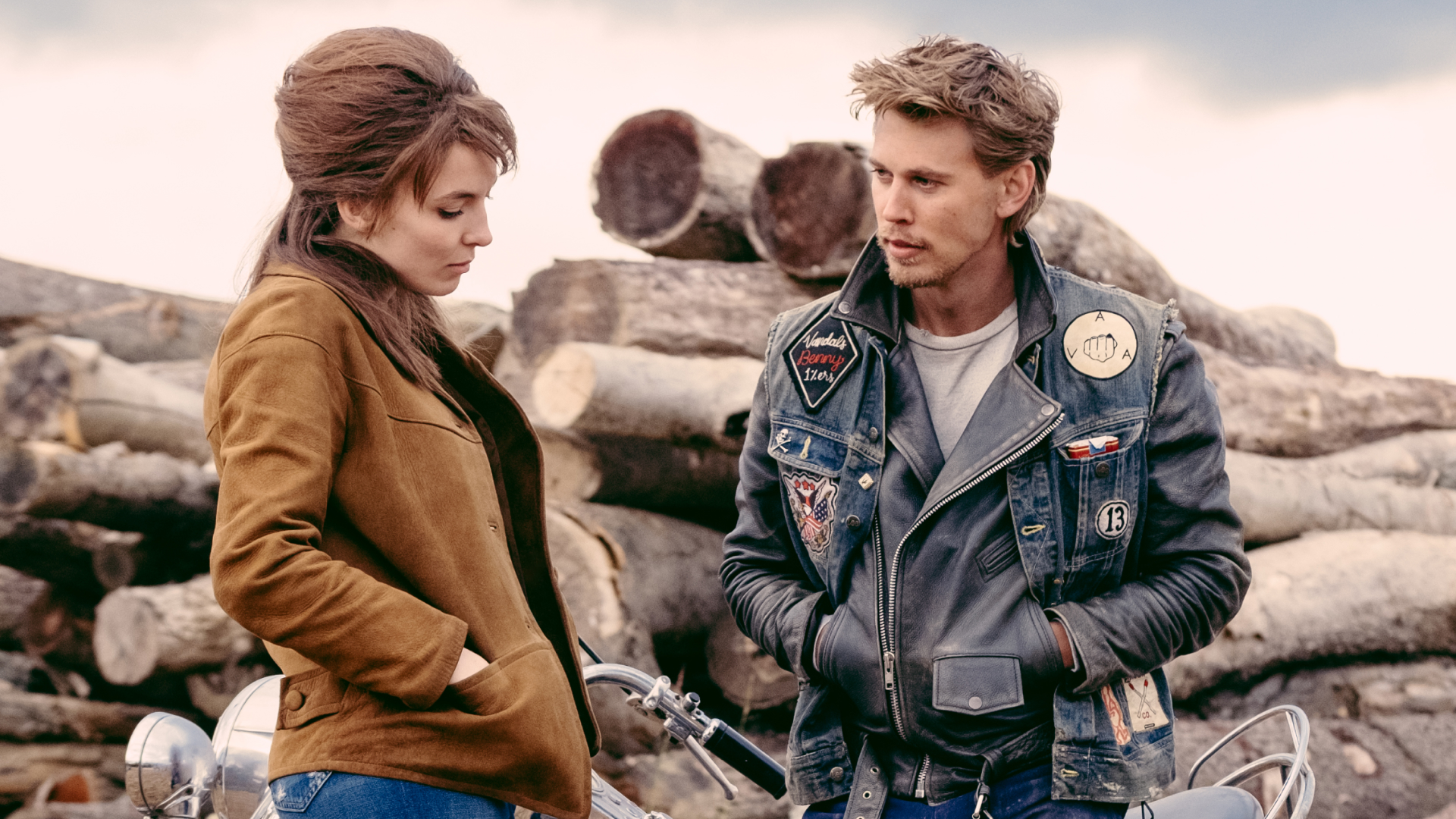
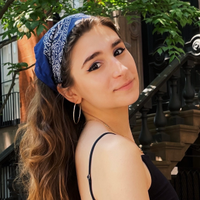
With a leather jacket on top and Levi’s jeans on the bottom, the biker look is arguably one of the most classic Americana fashions of all time. It’s an ensemble on full display in Jeff Nichols’ new historical drama The Bikeriders, which follows the fictional Vandals MC motorcycle gang outside of Chicago in the early ‘60s.
Adapted from journalist Danny Lyons’ 1968 photobook of the same name—which documented his travels with Outlaws Motorcycle Club in the midwest from 1963 to 1967— the film’s costume designer Erin Benach had her work cut out for her. Benach, whose credits include A Star Is Born, Birds of Prey, Drive, and Neon Demon, says that she first saw this project as being about the individual characters at the story’s helm—Tom Hardy’s club ringleader Johnny, Austin Butler’s young, freewheeling Benny, and his wife Kathy, played by Jodie Comer. “Secondly, it was about a subculture,” she tells Marie Claire. “Everything you could think of was this anti-norm, counterculture, liberating insanity.”
That subculture manifests itself in the film as a sort of haven for disenfranchised, working-class men in search of a community and the American dream—as well as one where masculinity is as fragile as the unraveling seams of a jacket. In the wardrobe, Benach captured that essence through extensive research of patches, outerwear, and denim. She and her team sourced pieces from vintage sellers, Levi’s and Lee, and workwear brands like Runabout Goods and VELVA SHEEN, among others. In doing so, she got Butler and Hardy ready to ride and also helped to transform Comer into a woman on the periphery of the scene.
As The Bikeriders arrived in theaters on June 21, Benach spoke with Marie Claire about the research she put into the project, how she used new and vintage textiles to design pieces for the film, and how she saw the stars transform into their characters.
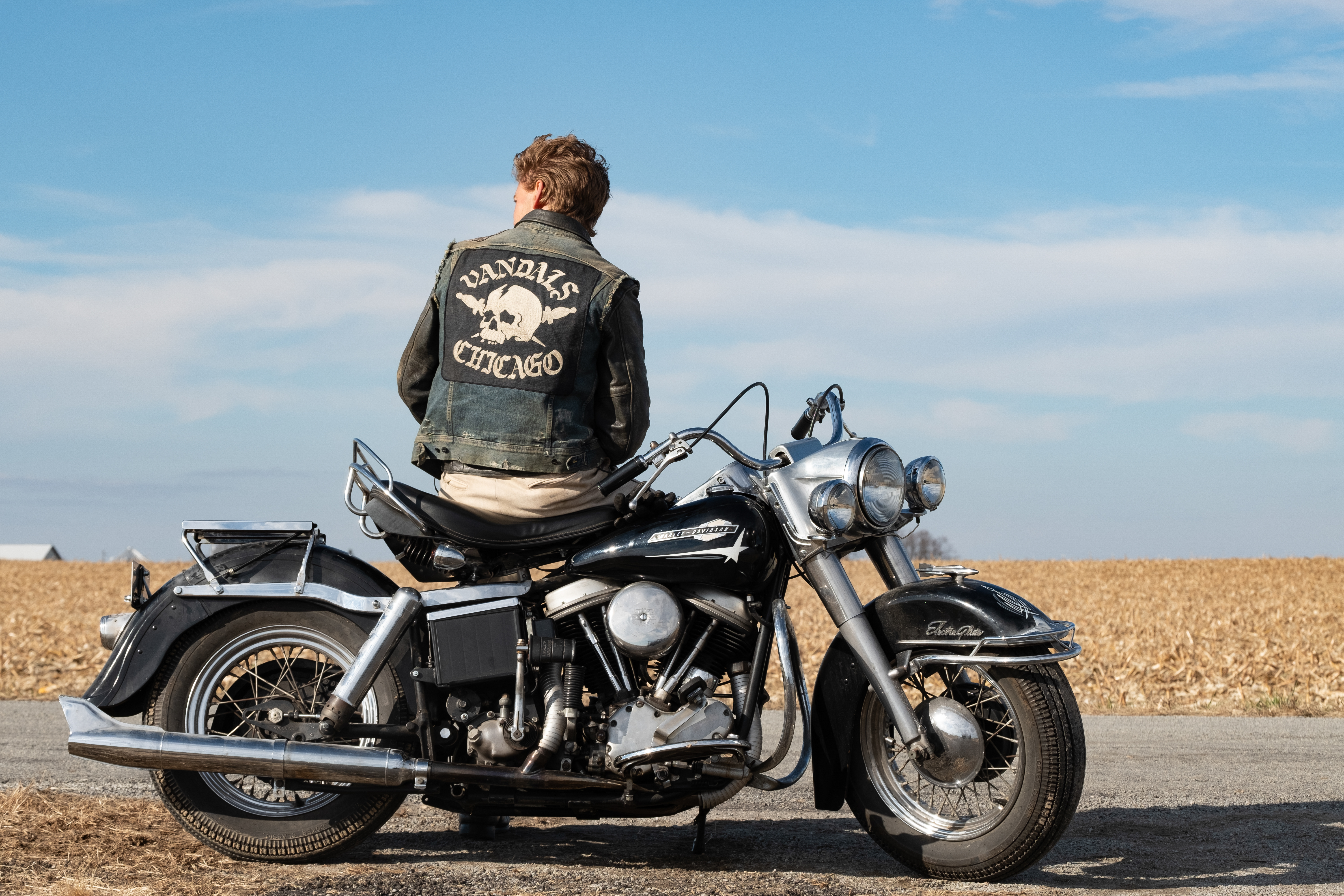
Benny wearing a Vandals MC leather jacket in The Bikeriders. "The bikeriders really had their own subculture, and their own way of putting their patches on and decorating with metalwork—everything was within their groups."
Marie Claire: Where did you first start researching for this film?
Erin Benach: This is my second project doing a historical story with Jeff [Nichols, following 2016’s Loving]. I knew we were going to go right to the source material first. I went right to Danny Lyons’ book, and upon looking at it and studying it a lot, I realized there was a lot of missing information outside the frame of the pictures. That's when I started doing deeper research, trying to understand, ‘What's the silhouette we really need for the pants?’
I found an amazing book called Portrait of American Bikers: Life in the 1960s. It was another photography compilation of bikeriders from around the same time up in Michigan, so it wasn't too far [from the film’s setting in Chicago]. There's this other amazing article that LIFE magazine did about the Hell's Angels during the same time period, and that was really helpful for [Norman Reedus’ character] Funny Sonny. It showed me how different the style was on the West Coast versus East Coast or middle of America; the bikeriders really had their own subculture, and their own way of putting their patches on and decorating with metalwork—everything was within their groups.
Get exclusive access to fashion and beauty trends, hot-off-the-press celebrity news, and more.

Norman Reedus as Funny Sonny arrives from California.
MC: The patches stand out as clear, fundamental identifiers. How did you go about creating them?
EB: We had to create our own versions because it was copyrighted material.So all those patches, we made and retooled and redesigned. It was a crazy undertaking. It was so much more detail-oriented than you think it is when you watch the movie, which is great— I don't want anybody to notice it. But it was just this process of figuring out what the kinds of patches they used back then. There was a lot of Americana iconography. There were a lot of flags. Then there was some really raunchy stuff. We only took it so far but tried to stay as honest and true as possible.
The ‘1%’ [patches that you see throughout the film] are [because] the American Motorcyclists Association had said ‘99 percent of our motorcyclists are law-abiding citizens,’ so the bikers took that as their cue because they got to be the 1 percent.
MC: Denim is as much of the wardrobe as leather is. Did you go into the Levi’s archive or have a specific process for sourcing the right jeans?
EB: We worked really closely with Levi's and Lee. I did a ton of research on cuts, styles, the 501s from back then, and the selvedge. When it comes down to fitting the bodies, sometimes even the things that are recreated don't quite fit the way they should, so we made a lot of the jeans, as well.
Denim was a really big part of this [subculture]. They wore it to the point where it molds to the body and it's like a second skin to them. It's not even blue anymore. They didn't wash their clothes very much at all. So, denim was a huge kind of character and learning curve.

A motorcycle brigade of Vandals MC, led by Butler's Benny.
MC: Many styles in the film feel contemporary, from the men wearing workwear as street style to the beatnik-like clothes Jodie Comer’s character wears. Was that intentional in any way or do you think it speaks to the timelessness of these looks?
EB: It really speaks to the timelessness of the looks. This look—the bikerider's look—is something that we still just wear exactly today. [There are] slightly different proportions maybe in our leather jackets and slightly different proportions in our denim, but one of the coolest things about the style of the film is that it is the most timeless style I can think of in the century, really.
And Jodie’s silhouettes with her tight-fitting knitwear, denim, and high-waisted [pants], it's what they were doing and it's what we're repeating.
MC: As a costume designer, is it a challenge for you to tackle something so timeless?
EB: There were definitely moments on this movie where I remember being like, ‘That doesn't look period enough.’ I would redo and redo and redo to be like, ‘Something's not right here.’ Like, ‘Some part of the silhouette or some part of the fabric and the way it's laying, it doesn't feel authentic.’ So it was harder than I anticipated.
One of the coolest things about the style of the film is that it is the most timeless style I can think of in the century, really.
MC: Did you get to see Austin Butler, Tom Hardy, or Jodie Comer transform into their characters in the fittings—maybe when they put on their jackets?
EB: Fittings are by far the greatest things that we get to do. It’s the reason I'm not a fashion designer and I am a costume designer. You really get to see a character come out and you see an actor turn into a character. We're like the first line of defense; we're the first people that they often meet with on the film. Maybe they've met with the director once, but other than that, we're it [when] they're first starting to even think about their character a lot of the time.
I flew to London to do Jodie and Tom, and they were first figuring out who these characters are. Jodie and I figured out together Kathy in that first fitting. Kathy didn’t change when her life became intertwined with the bikeriders. She always has this sense of self. It was important to us that she didn't become a biker chick and that she didn't fold in.
I remember with Austin, it was all about figuring out that silhouette because everything we put on him, it looked modern and too low-waisted. He has very long legs and his torso is a little shorter, so we had to build up the waistline to give it a deeper height for him.
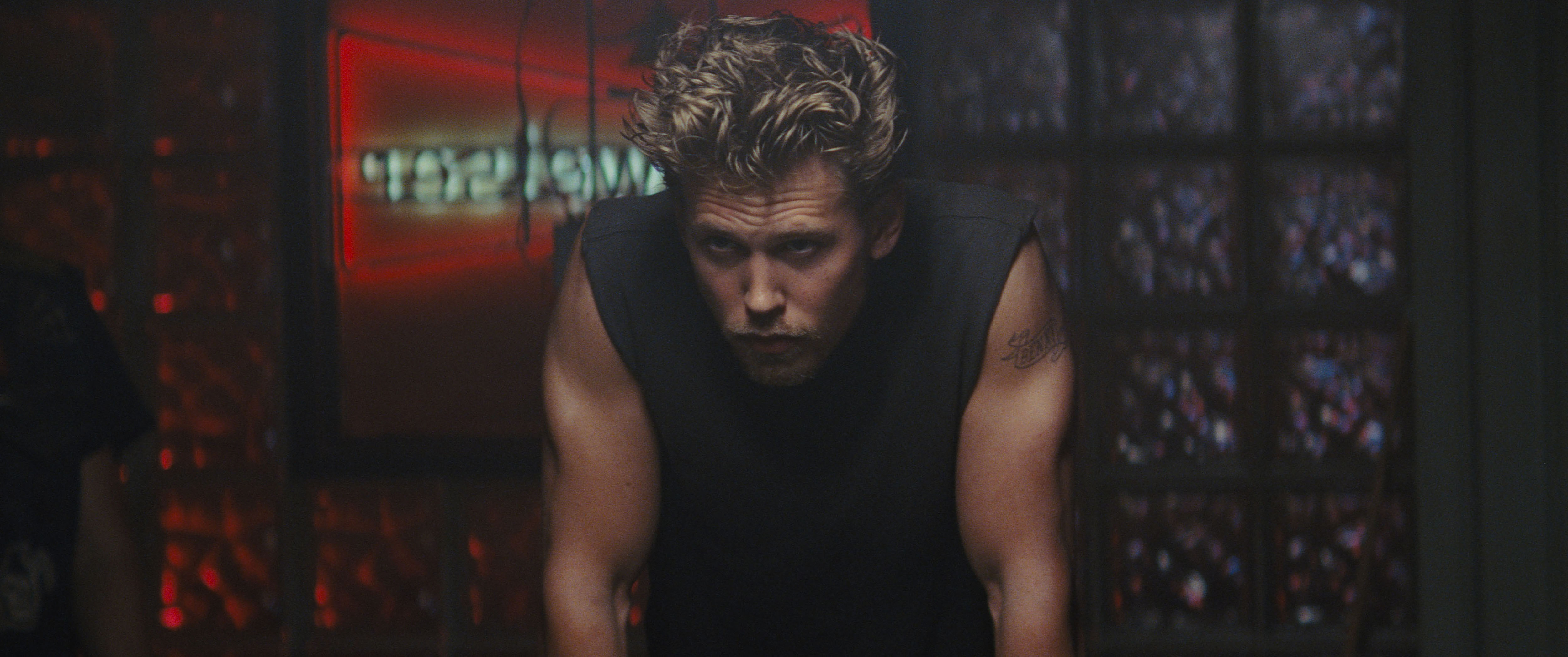
Benny, played by Austin Butler, has an instantly iconic introduction in the film, standing over a pool table.
MC: That’s so funny about Austin because he has such a James Dean-like essence, and the first shot of him standing over the pool table is so striking.
EB: He can definitely do that to a room. That image of that cut-off shirt was directly lifted from Danny Lyons. It was something that Jeff, from the very beginning, was like, ‘We're going to recreate this shot.’ It was very specific and very planned out. For me, recreating a picture is so interesting. You're like, ‘Is that T-shirt material? Is that sweatshirt material?’ I had never done it so specifically. I'd always used reference imagery to help assist in recreating something, but not to the point of like, ‘This picture,’ or, ‘This T-shirt.’ It was like you had a limitation and you had to nail it.
A huge part of it was our ager/dyer Troy David. It was a T-shirt and we cut the sleeves off, and it was a sweatshirt, and we cut the sleeves off, and [they] were flat black. Troy does this amazing spray paint dusting to give it all this age and depth, it catches the light and doesn't look flat-black. It looks worn forever, so there are all those fun movie tricks happening, too.

Jodie Comer as Kathy stands next to Benny during a funeral scene. "Kathy didn’t change when her life became intertwined with the bikeriders. She always has this sense of self."
MC: As classic and feminine as Kathy’s looks are, she almost exclusively wears pants in the film. Did her style factor into this story of masculinity at the center of the film?
EB: It was more a story of Kathy. Kathy has a lot of masculinity in her personality. So I think it was a story about [how] she has a very non-abiding, I don't really give a [f---] about everybody else and what they think I should be and what they think I should do. To be able to infiltrate that world and stay in it and survive, it takes a certain underlying strength for her.
When Jodie would put on the clothes and we would be in our fittings, we used to have this joke: ‘FUPA first’. She'd have to thrust her hips forward, because Kathy just had this stance. That’s part of what an actor does: They find the position of character. She found it in the fitting—just leaning with your hips forward—and there’s a real I-don’t-care element to the way she stands to fill out into that masculinity. I would put her in little pink sweaters and all those things, but the stance was still there.
Her jeans were from Imogen + Willie in Nashville and all her sweaters were vintage from the time. Sometimes this happens when I read this script for the first time, I can really picture things. I had this vision of her in purple when she walked into the bar. There's something about her being in this color that would never ever be in an Americana biker bar. Purple seemed like the most out-of-place color. We needed multiples for that look because she has a stunt rider and I was like, ‘No, it's this purple and this is the only purple. We have to find multiple ones or we're going to start building it.’
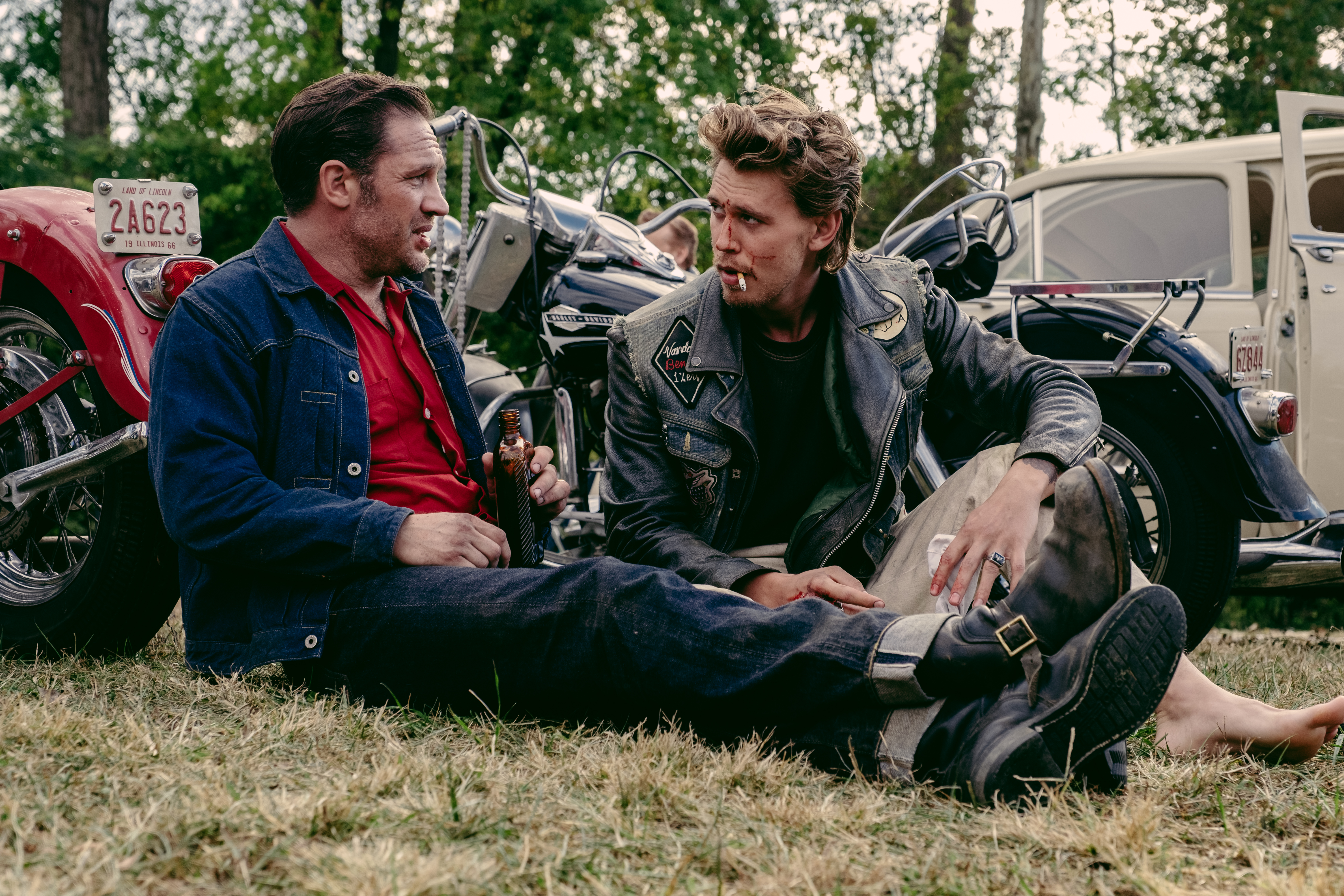
Johnny (Tom Hardy) and Benny seen talking after a fight breaks out.
MC: Where did you go sourcing vintage for the wardrobe?
EB: For this, I was in London, Cincinnati, and Los Angeles. In London, I would start out in Camden Street Market at your typical vintage store places, but then you start to meet the owners, and they start to talk about their friends who have collections that are what we're looking for. And then you wind up going to some warehouse with some guy who has like 600 leather jackets in his warehouse.
That day, my assistants and I were going on a whim an hour outside the city thinking, ‘This could be like a total bust,’ and we got there and it was like a Mecca, Shangri-La moment. He's like, ‘Yeah, I don't know why I'm saving all these leather jackets. It’s been so long. You want them? Tell me how much you want them for.’ We had wheelbarrows of the stuff. It was hilarious.
In L.A., I go to Mothfood, Melet Mercantile, Rose Bowl Flea Market, and Pasadena College Flea Market. But it’s very fun once you start peeling back the layers. The ‘60s are far enough back where you're not really seeing it in typical thrift stores.
Tom’s [jacket] was a vintage find. It's a deep pocket, vintage leather jacket. As soon as he put it on, we were like, ‘This is the one.’
MC: You also were the costume designer on Drive, in which Ryan Gosling wears a really incredible jacket. What would you say goes into making an iconic jacket?
EB: It’s like any chef in a kitchen; it's a bunch of things. But I think the fit and the character, first and foremost. Are they a heroic character in some way? Do they penetrate your memory? Do they take you by surprise? Do they impress upon you something that you had not felt before? And the actor wearing it, and how they wear it.
Then as far as the design goes, I don't work from the outside in, I work from the character out. I'm never looking to try to make an iconic jacket. I'm always thinking, What would be iconic? Meaning, something about it that feels like a strong element, whether it’s a graphic or a two-tone or lining or something that makes it feel different than everybody else in the film. It's so many things. But I do love doing that, and I immediately gravitate towards that piece when I start a project. I don't force it, but it does appeal to me.
This interview has been edited and condensed for clarity.

Sadie Bell is the Senior Culture Editor at Marie Claire, where she edits, writes, and helps to ideate stories across movies, TV, books, music, and theater, from interviews with talent to pop culture features and trend stories. She has a passion for uplifting rising stars, and a special interest in cult-classic movies, emerging arts scenes, and music. She has over nine years of experience covering pop culture and her byline has appeared in Billboard, Interview Magazine, NYLON, PEOPLE, Rolling Stone, Thrillist and other outlets.